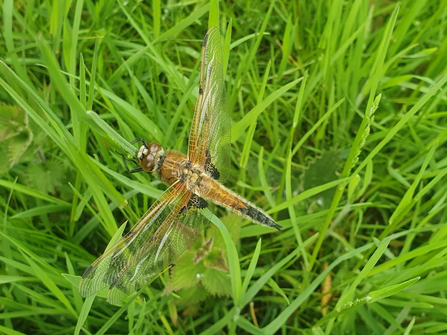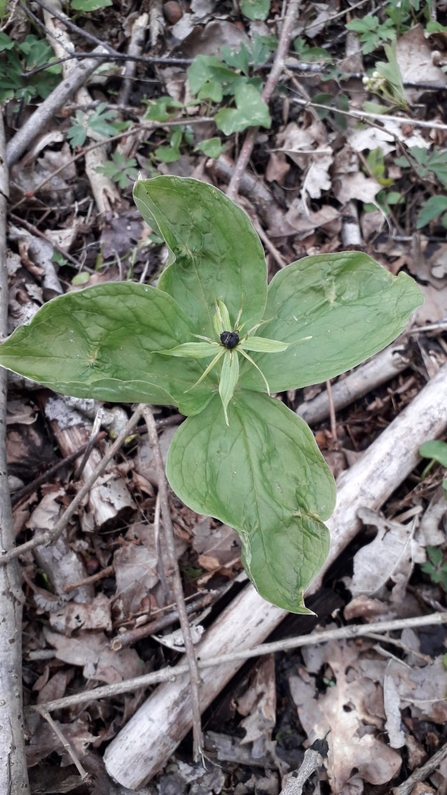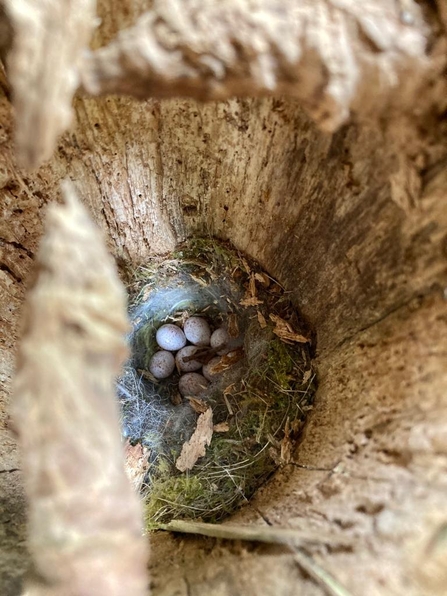Weekly wild news from our reserves - 28 May
British white cattle at Hen Reedbeds
The team at Foxburrow Farm enjoyed this lovely swarm of bees which descended next to the wildlife pond. Natural swarms like this often move off to a suitable nest site on their own accord.
Owl mystery solved!
These (slightly gruesome!) remains of an owl were found in the entrance of a badger sett at Trimley Marshes recently. Pete Merchant, one of our brilliant volunteers, took it upon himself to identify the species by examining the primary wing feathers, bill and tarsus – and concluded it was a male short-eared owl. We don’t think the badgers would predate these large birds of prey, but rather the bird might have been killed by something else, then the opportunistic badgers may have fed on the remains.
Spotting spots
Anecdotally, spring is certainly on the drag compared with last year and with it those proliferations of flying insects not yet so apparent. However, Joe Bell-Tye's keen eye zoomed in on his first dragonfly of the year this week, a stunning four-spotted chaser at Lackford Lakes. Joe said ‘four-spotted chasers spend a lot of time hawking over water for insect-prey or to mark out their territories. They mate on the wing; the female then hovers over the water, dipping the tip of her abdomen into drop her eggs on to vegetation below the surface. Both sexes are golden-brown, getting darker towards the tip of the body, and with yellow spots along the sides. Two dark spots at the front edge of each wing give this dragonfly its name and an easily recognisable appearance.’

Four spotted chaser – Joe Bell-Tye
Cows return to Hen
Our conservation grazers seem excited about returning to Hen Reedbeds for the summer months.
Herb paris
Certain plants are used as indicators of how old a woodland is, although these plants may differ from region to region, simply because habitats, soils and conditions change the flora present. Herb-paris is used as an indicator of ancient woodlands mainly on moist chalky soils and is very scarce in Scotland and West Wales, and absent from the extreme south-west of England. The photo pictured here is from a patch of plants growing at Bradfield Woods. With its whorl of four egg-shaped leaves, it is known as the 'herb of equality' because all of its parts are considered equal and harmonious. This symmetry appealed to medieval herbalists, so it was used both in marriage rituals and to guard against witches. Rising from the middle, an upright stem bears a flower: a star of four narrow, yellow-green petals and four green sepals, topped by a dark berry (ovary) and a crown of eight golden stamens. The scientific and common names for herb-paris are derived from the Latin par, meaning pair, referring to the symmetry of the pairs of leaves and floral parts (not the city Paris).

Herb-paris - Alex Lack
Next stop, the bund at Bess’ Hide
If you’ve yet to see your first swift of the year, then ‘swift central’ can be found at the bund at Bess' Hide, Lackford Lakes. Check out Joe’s video clip capturing these majestic birds flying around the insect-studded skies above the reserve’s watery margins.
Nest in a tight spot
This bird's nest is very well concealed tucked into a rotten fence post at Blaxhall Common!

Birds nest in a rotten fence post at Blaxhall Common - Ben Calvesbert

